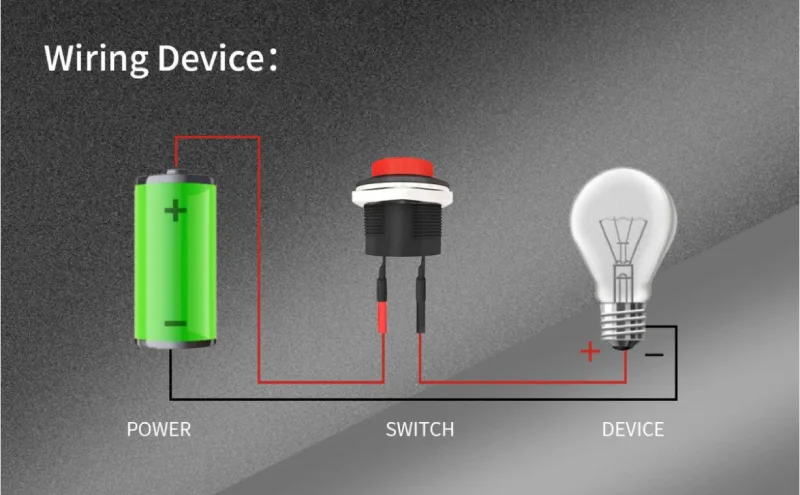A diferença entre um interrutor de botão de 2 pinos e um interrutor de botão de 4 pinos reside na sua estrutura, funcionalidade e aplicações, sendo que o último oferece mais versatilidade e estabilidade em dispositivos electrónicos complexos.
Descrição geral do interrutor de botão de 2 pinos

Cablagem do botão de 2 pinos
Um interrutor de botão de 2 pinos é um componente simples mas eficaz em circuitos electrónicos, concebido com dois terminais que completam ou interrompem um circuito quando pressionados. Este design simples torna-o ideal para aplicações básicas de ligar/desligar em aparelhos domésticos, brinquedos e projectos electrónicos elementares. A funcionalidade de um interrutor de 2 pinos é simples: quando ativado, permite o fluxo de corrente e, quando libertado, interrompe o fluxo, proporcionando um método de controlo claro e direto para vários dispositivos. Embora estes interruptores ofereçam facilidade de utilização e sejam suficientes para muitas tarefas básicas, podem não ter a estabilidade e versatilidade encontradas nos seus homólogos de 4 pinos, particularmente em configurações electrónicas mais complexas.
Caraterísticas do interrutor de botão de 4 pinos

Botão de 4 pinos para torcer
Os interruptores de botão de 4 pinos oferecem maior funcionalidade e estabilidade em comparação com os seus homólogos de 2 pinos. Estes interruptores apresentam normalmente quatro terminais ligados internamente em dois conjuntos, proporcionando um suporte adicional quando montados num dispositivo. Os pinos extra podem servir para vários fins, como alimentar uma luz indicadora LED no interior do interrutor ou controlar vários circuitos em simultâneo. Esta versatilidade torna os interruptores de 4 pinos particularmente úteis em dispositivos electrónicos complexos e projectos de microcontroladores, onde podem fornecer sinais de entrada ao mesmo tempo que acendem um LED para indicar o estado. O design dos comutadores de 4 pinos também permite uma maior flexibilidade na disposição das placas de circuitos, uma vez que os pinos adicionais podem ser utilizados para saltar faixas, simplificando o design da placa de circuito impresso.

Aplicações dos interruptores de botão
Os interruptores de botão têm diversas aplicações em vários sectores e dispositivos. Os interruptores de 2 pinos são normalmente utilizados em aparelhos domésticos, brinquedos e projectos electrónicos básicos devido à sua simplicidade e facilidade de utilização. Por outro lado, os interruptores de 4 pinos são frequentemente utilizados em dispositivos electrónicos mais complexos, como microcontroladores como o Arduino e o Raspberry Pi. Estes interruptores são particularmente úteis em projectos em que é necessária uma funcionalidade adicional, como indicadores LED ou controlos de circuitos múltiplos. A escolha entre interruptores de 2 e 4 pinos depende, em última análise, dos requisitos específicos da aplicação, sendo que os interruptores de 4 pinos oferecem maior versatilidade e estabilidade para configurações electrónicas mais sofisticadas.
Comparação de interruptores de botão
Ao comparar os interruptores de botão de 2 e 4 pinos, surgem várias diferenças importantes:
- Tratamento atual: Os comutadores de 4 pinos têm frequentemente valores de corrente mais elevados, o que os torna adequados para aplicações que requerem uma maior capacidade de potência.
- Estabilidade: Os pinos adicionais nos comutadores de 4 pinos proporcionam uma maior estabilidade mecânica quando montados em placas de circuitos.
- Flexibilidade de conceção de PCB: Os interruptores de 4 pinos oferecem mais opções para a disposição da placa de circuito impresso, uma vez que os seus pinos extra podem ser utilizados para contornar pistas, simplificando a conceção do circuito.
- Custo e complexidade: Os interruptores de 2 pinos são geralmente mais simples e mais económicos para aplicações básicas, enquanto os interruptores de 4 pinos podem ser preferidos para projectos mais sofisticados que exijam funcionalidade ou robustez adicionais.


